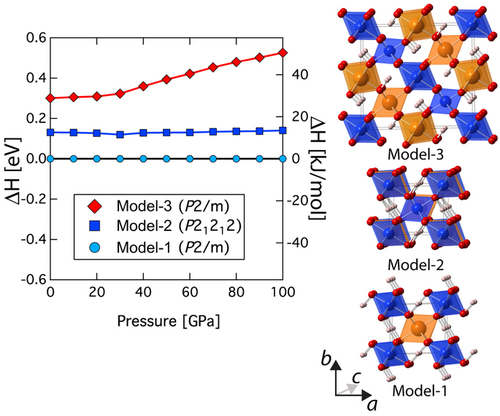Research Highlights
Crystal structure, equation of state, and elasticity of phase H (MgSiO4H2) at Earth's lower mantle pressures
Abstract
Dense hydrous magnesium silicate (DHMS) phases play a crucial role in transporting water in to the Earth's interior. A newly discovered DHMS, phase H (MgSiO4H2), is stable at Earth's lower mantle, i.e., at pressures greater than 30 GPa. Here we report the crystal structure and elasticity of phase H and its evolution upon compression. Using first principles simulations, we have explored the relative energetics of the candidate crystal structures with ordered and disordered configurations of magnesium and silicon atoms in the octahedral sites. At conditions relevant to Earth's lower mantle, it is likely that phase H is able to incorporate a significant amount of aluminum, which may enhance the thermodynamic stability of phase H. The sound wave velocities of phase H are ~2-4% smaller than those of isostructural δ-AlOOH. The shear wave impedance contrast due to the transformation of phase D to a mixture of phase H and stishovite at pressures relevant to the upper part of the lower mantle could partly explain the geophysical observations. The calculated elastic wave velocities and anisotropies indicate that phase H can be a source of significant seismic anisotropy in the lower mantle.
 Energetics of order-disorder in phase H.
Energetics of order-disorder in phase H.
Left panel shows the plot of enthalpy as a function of pressure for model-1, model-2, and model-3. In the right panel, the optimized zero pressure crystal structures for model-1, model-2, and model-3 are shown.
 Pressure dependence of unit-cell volume and lattice parameters.
Pressure dependence of unit-cell volume and lattice parameters.
The left panel shows the plot of unit-cell volume as a function of pressure for phase H with ordered Mg and Si atoms (model-1) (light blue filled symbol). Also, shown are the metastable extensions of unit-cell volume for the symmetric hydrogen bonded structure (light blue open symbols). Inset shows the plot of rO−H as a function of , at around 30 GPa, becomes (1/2) of , i.e., hydrogen bond symmetrizes. The right panel shows the plot of the a-, b-, and c-axes as a function of pressure. Inset shows the plot of γ as a function of pressure. For comparison, the experimental results are also plotted (open symbols) and (grey filled symbols).
Reference
Authors: Jun Tsuchiya & Mainak Mookherjee
Title of original paper: Crystal structure, equation of state, and elasticity of phase H (MgSiO4H2) at Earth's lower mantle pressures
Journal: Scientific Reports 5, Article number: 15534 (2015)
DOI : 10.1038/srep15534












